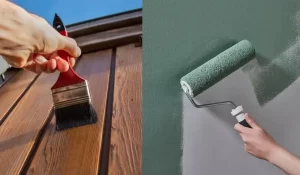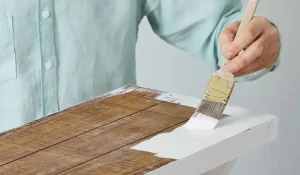Well, well, well! Can you use wall paint on wood? That’s a question that’ll invite in a truckload of opinions. Picture this: you find yourself with some leftover wall paint, and you think to yourself, “Hmm, I wonder if I can use this on that wooden chair I’ve been meaning to spruce up.
Well, drumroll please…the answer is yes. But before you go slathering on that paint with reckless abandon, there are a few things you need to keep in mind. See, wood is a bit of a tricky customer, but with the right prep work, you can transform that dull plank into a work of art.
When it comes to painting on wood, proper adhesion is of the utmost importance. Think about it: if you don’t care when laying down the paint and primer, your masterpiece will soon become an eyesore with chipping and peeling surfaces. That’s why you need to be extra careful before starting any project.
Let’s open up this discussion and see what the experts have to say. Are you feeling brave enough to try it out for yourself? Let’s find out.
Is Wood Paint Different from Wall Paint?
I am sure you wonder if there is a difference between wood and wall paint. The answer is yes; there is a difference. Wall paint is typically made of latex, a type of plastic. This makes it more flexible and less likely to crack than other types of paint. Wall paint also has a higher level of pigmentation than wood paint. This means that wall paint will provide better coverage and be more durable than wood paint.

When talking about wood paint, we are usually talking about oil-based paint. This type of paint is made with a base of oil, making it more durable and resistant to wear and tear. This type of paint is more difficult to apply than wall paint. It is also more likely to drip and run when you are painting. Oil-based paint is also more likely to yellow over time.
The main difference between wood and wall paint is the type of pigment used. Wall paint is made with a type of pigment that is more durable and provides better coverage. Wood paint is typically made with an oil-based pigment that is more difficult to apply and is more likely to yellow over time.
What are Different Types of Wall Paint?
Wall paint is a type of paint that is specifically formulated for use on walls. It is usually thicker and more durable than regular interior paint, ideal for high-traffic areas like hallways and kitchens. Wall paint can also create interesting textural effects, such as stripes or faux finishes.
Here is the detail of some of the most popular types of wall paint:
1. Latex-based Paints:
This type of wall paint is made with water-based acrylic resins and latex. It is the most popular type of wall paint because it is easy to apply and clean up and is a low odor. Latex-based paints also have good resistance to mold and mildew.
These paints contain vinyl or acrylic resins and are known for durability and flexibility. The synthetic resins of polyvinyl acetate (PVA) or polyvinyl chloride (PVC) make the paint more resistant to moisture and humidity. This type of paint is ideal for use in high-humidity areas such as kitchens and bathrooms.
Latex-based paints are also available in a range of finishes, from high-gloss to flat.
2. Oil-based Paints:
Oil-based paints are made with alkyd resins suspended in an oil solvent. They resist stains and moisture, making them ideal for use in high-traffic areas and kitchens. Oil-based paints are also durable, and you can use them on various surfaces, including wood, metal, and plaster.
However, oil-based paints have a strong odor and are more difficult to apply than latex-based paints. They also require special care when cleaning up, as the paint thinner can harm your skin. I would say that oil-based paints are best suited for experienced painters.
3. Enamel Paints:
Enamel paints are made with a varnish or resin base and contain pigments that give them their color. They are known for their high gloss finish and durability. Enamel paints are ideal for metal surfaces, such as railings, pipes, and gutters.
However, enamel paints can be difficult to apply and have a strong odor. They also require special care when cleaning up, as the paint thinner can harm your skin. In my experience, if you are looking for a high gloss finish then enamel paints are the best choice.
4. Hybrid Paints:
Hybrid paints are a type of wall paint mix of latex and oil-based resins. These paints have the benefits of latex and oil-based paints, making them durable and resistant to stains and moisture.
They also have good resistance to mold and mildew, making them ideal for use in high-humidity areas. Hybrid paints are also available in a range of finishes, from high-gloss to flat.
5. Chalkboard Paints:
Chalkboard paint is wall paint that you can use to create a chalkboard surface on walls. This type of paint is usually black or green, and you can find it in a variety of finishes, from high-gloss to flat.
Chalkboard paint is perfect for those who want to create a chalkboard surface in their home. This type of paint is also great for kids, as it provides a fun and interactive way for them to learn and play.
6. Milk Paints:
Milk paints are made with milk proteins and pigments that give them their color. They are known for their chalky finish and durability. Milk paints are ideal for use on various surfaces, including wood, metal, and plaster.
However, milk paints can be difficult to apply and have a strong odor. They also require special care when cleaning up, as the paint thinner can harm your skin. I would say that experienced painters often choose milk paints.
Wall paints are available in various colors, finishes, and textures. You can choose from a variety of colors to create the perfect look for your home.
How to Determine if Wall Paint Can Be Used on Wood?
In order to determine if wall paint can be used on wood, it’s important first to assess the surface that needs to be painted. If the wood is highly porous and rough, it’s likely best to use special wood paint instead of wall paint. However, if the wood is smoother, wall paint may provide better adhesion results. It’s also important to ensure the wall paint is compatible with a wood primer, as this will help ensure proper adhesion.
Additionally, it’s always best to test the wall paint on a small area of the wood before committing to an entire project. This way you can determine how well the wall paint sticks and if any additional prep work or preparation is necessary to ensure proper adhesion.
Tips for Ensuring Proper Adhesion
A. Surface Preparation
Surface preparation is essential for ensuring that the paint adheres properly to the wood. Start by sanding down the surface of the wood with fine-grit sandpaper to remove any imperfections or rough patches. Once you’ve finished, make sure to clean away any dust particles before moving on.
B. Primer
Using a quality primer can make all the difference regarding adhesion. Primer helps to seal the wood and create a better surface for the paint to stick to. Be sure that you choose a primer that is compatible with wall paint, then follow the manufacturer’s instructions when applying.
1. Types of primer
There are several types of primer available on the market, each designed specifically for certain surfaces.
Oil-based primers are suitable for outdoor wood projects, while water-based primers can be used for either interior or exterior wood projects.
Additionally, there are aerosol primers that are convenient and easy to use and oil-free formulas that help to reduce the odors associated with oil-based primers.
How to apply primer?
When applying primer, it’s best to do so in thin coats. This not only helps to ensure proper adhesion but also prevents any brush marks or drips from occurring on the surface of your project. Allow each layer of primer to dry before applying the next.
C. Apply the Paint
Once the primer has had time to dry, you can begin applying the paint. Start by brushing in one direction and then use a roller or brush to spread the paint evenly over the wood’s surface. Be sure to keep a wet edge when working to ensure an even coat of paint is applied.
1. Tips for applying paint
When painting wood, it’s important to know the difference between wall paint and wood paint. Wall paints are typically more flexible and made of latex binders, which make them better for adhering to flat surfaces like walls.
Meanwhile, wood paints contain special binders designed to adhere better to wood substrates and often include additives such as linseed oil to help the paint penetrate and bond with the wood grain.
To determine which type of paint is best for a particular project, it’s important to assess the surface that needs to be painted. If the wood is highly porous and rough, it’s likely best to use special wood paint instead of wall paint, though if it’s smoother, it may provide better adhesion results.
2. Discussion of brush vs. spray methods
When it comes to painting wood, several different methods can be utilized.
For a smooth finish, using a brush is the best choice, as it will allow you to get into all the nooks and crannies in the wood grain and provide an even coat of paint. However, if you’re looking for a more textured finish, a roller can be used to apply the paint. Make sure to look for rollers specifically designed for painting wood surfaces, as this will help ensure proper adhesion.
Spraying is another popular method and generally provides the most even coverage. However, it’s important to remember that when spraying, you should never go against the wood grain and should always keep the nozzle of the spray gun at least 8 inches away from the surface. Also, be sure to use a mask to avoid inhaling any paint particles.
What Paint Will Stick to Wood?
You can paint over painted wood, as long as you sand the surface first to rough it up a bit and give the new paint something to grip. You can also use a primer specifically to cover dark or bright paint colors on surfaces like walls, trims, and cabinets.
Choose your paint carefully, depending on the look you want and the type of wood you’re working with. You might want to use wall paint on wood if you’re hoping to achieve a certain look for a piece of furniture or trim work in your home. But does this type of paint actually adhere to wood surfaces?
The short answer is yes; you can use wall paint on wood. But there are a few things you should keep in mind before you start painting, including the type of paint you use and the condition of the wood itself.
If you’re hoping to achieve a smooth, even finish on your wood surface, it’s important to choose the right paint. A latex wall paint is a good option for painting over wood, as it’s easy to work with and dries quickly. You can also use oil-based paint, but be aware that it takes longer to dry and can be more difficult to work with.
Make sure the wood surface is clean and free of any dirt or debris before you start painting. You might want to sand the surface lightly to create a smooth texture for the paint to grip. If the wood is in poor condition or has a lot of knots, you might want to use a primer before painting to help the paint adhere better.
Once you’ve chosen the right paint and prepared the surface, you can start painting. Begin by painting the edges and corners of the wood surface, then work your way toward the center. Use even strokes, and be sure to paint all sides of the wood for the best results.
Allow the paint to dry completely before using or handling the wood surface. Once it’s dry, you can enjoy the new wood piece that you have painted.
Can you Use Emulsion Paint on Wood?
This is a question people ask us a lot here at my paint shop. The short answer is yes, you can, but there are a few things you need to bear in mind before you start painting.

For instance, the type of wood you are painting will make a difference in how the paint adheres. Smooth surfaces like MDF or laminate will need a primer before painting, whereas rougher surfaces like woodchip or sanded wood won’t need one.
If you are painting bare wood, you will also need to consider what kind of paint you use. Water-based paints are generally best for indoor use, while oil-based paints are better outdoors.
Once you’ve chosen the right paint, it’s time to paint. Ensure you follow the instructions on the tin for the best results and enjoy giving your wood a new lease of life.
Can Dulux Wall Paint be Used on Wood?
Dulux paint is a high-quality paint product that you can use on various surfaces, including wood. However, it is important to note that not all Dulux paints are suitable for wooden surfaces. Some Dulux products contain chemicals that can damage or discolor wood.
Some wood surfaces, such as unfinished pine or cedar, can also stain by paint. If you’re using Dulux paint on wood, be sure to test it on a small, inconspicuous area first to ensure that it won’t damage or discolor the surface.
Dulux wall paints can add a touch of elegance and style to any room in your home. However, before you use Dulux paint on wood, it’s important to understand how the product works and what types of wood are suitable for painting. By taking the time to learn about Dulux paint, you can ensure that your next painting project is a success.
Can I Use Water-Based Paint on Wood?
Water-based paints are safe for use on wood as long as you have properly sealed the wood. Paint will not adhere to wood that you didn’t seal, so it is important to ensure that your wood surfaces are clean and free of any dirt, grease, or other contaminants before painting. Once you have sealed the wood, you can paint it with water-based paint, including latex or acrylic paints.
Water-based paint will not last as long as oil-based paint, and it is not as durable. It is also more difficult to apply evenly. If you are going to use water-based paint, make sure you sand the wood first and apply a primer.
Which Paint Can You Use on Wood?
We can use water-based paint, latex paint, and acrylic paint on wood. All these types of paints are safe for use on wood as long as you seal the wood properly. Paint will not adhere to unsealed wood, so it is important to make sure that you seal the wood before attempting to paint it.
Water-based paint is the safest and most versatile type of paint to use on wood. It is easy to clean up with soap and water, and it dries quickly. Latex paint is also safe for use on wood, but it can be more difficult to clean up if you spill it. Acrylic paint is also safe for use on wood, but it can be more difficult to work with because it dries very quickly.
When painting wood, always use a primer before applying the paint. This will help the paint to adhere better to the wood and will also help to prevent peeling and flaking. Always sand the wood before painting it, and be sure to use a different type of sandpaper for each coat of paint.
Start by painting the edges of the wood, and then work your way in towards the center. Use a brush or a roller to apply the paint, and be sure to go over each area multiple times to ensure that you have applied the paint evenly. Allow the paint to dry completely before moving on to the next coat.
Frequently Asked Questions:
What kind of paint do you use on wood?
You can use any kind of paint on wood, as long as you seal it properly. For best results, use a sealer or primer before painting, and follow up with a top coat of paint. You can also choose to paint your wood furniture with a distressed finish for a more rustic look.
Can you use Matt wall paint on wood?
Yes, you can use Matt wall paint on wood. Just make sure to seal the wood first so that the paint does not chip or peel over time.
Can you use masonry paint on wood?
Yes, you can use masonry paint on wood. Masonry paint is a type of exterior paint to withstand the elements. It will not chip or peel like regular paint, so it is perfect for painting wood siding or trim.
Can you paint straight onto plywood?
Yes, you can paint straight onto plywood. However, it is best to prime the plywood first so that the paint does not soak in and warp the wood.
Can you use wall paint on MDF?
You can use wall paint on MDF without any special preparation. Just sand the surface lightly before painting to help the paint adhere better. Also, be sure to use acrylic or latex-based paint for best results.
Can you use paint for walls and ceilings on wood?
You can use paint for walls and ceilings on wood, but it’s best to sand the surface first to help the paint adhere better. Also, be sure to use acrylic or latex-based paint for best results.
Can you use wall paint on wooden doors?
Yes, you can use wall paint on wooden doors. Just sand the surface lightly before painting to help the paint adhere better. And be sure to use acrylic or latex-based paint for best results.
Can I use emulsion paint on wood?
Yes, you can use emulsion paint on bare and previously painted wood. It’s perfect for busy areas such as kitchens and playrooms as it’s tough and washable.
How to choose outdoor paint for wood?
When painting any piece of outdoor wood furniture, it’s important to use the paint that the manufacturer has designed for this job. Look for a product that is weather-resistant or UV resistant. These products will contain additives that help the paint withstand the elements.
Is acrylic an exterior wood paint?
Yes, you can use acrylic paint on exterior wood. It is a water-based paint that is versatile and easy to use. Acrylic paint dries quickly and does not require a primer, making it a good choice for painting small projects.
What kind of paint to use on outdoor rocking chairs?
For outdoor rocking chairs, you will want to use durable paint to withstand the elements. A good choice would be exterior paint or UV-resistant paint.
How to waterproof painted wood furniture for outdoors?
To waterproof painted wood furniture outdoors, you will want to use a sealer or a clear coat of paint. Apply the sealer or paint to the furniture’s surface and allow it to dry. This will help protect the paint from weather damage and extend the life of your furniture.
Conclusion:
In conclusion, Can you use wall paint on wood? The answer is absolutely “Yes ” – painting wood is an easy process when done properly. Preparing the surface and applying quality primer and paint is essential for achieving a good-looking finish. Before beginning a project, take the time to properly assess the surface and choose the right primer and paint accordingly.
Regarding application methods, brush painting provides a smooth finish, rolling is ideal for textured surfaces, and spraying is a quick way to get an even coat of paint. No matter which method you choose, always remember to work in thin coats and keep a wet edge.
With these tips, you can ensure your wood projects look their best! With the right preparation and products, painting wood is an easy process that will help bring any project to life. Good luck!



5 thoughts on “Can You Use Wall Paint on Wood? Tips for Ensuring Proper Adhesion”